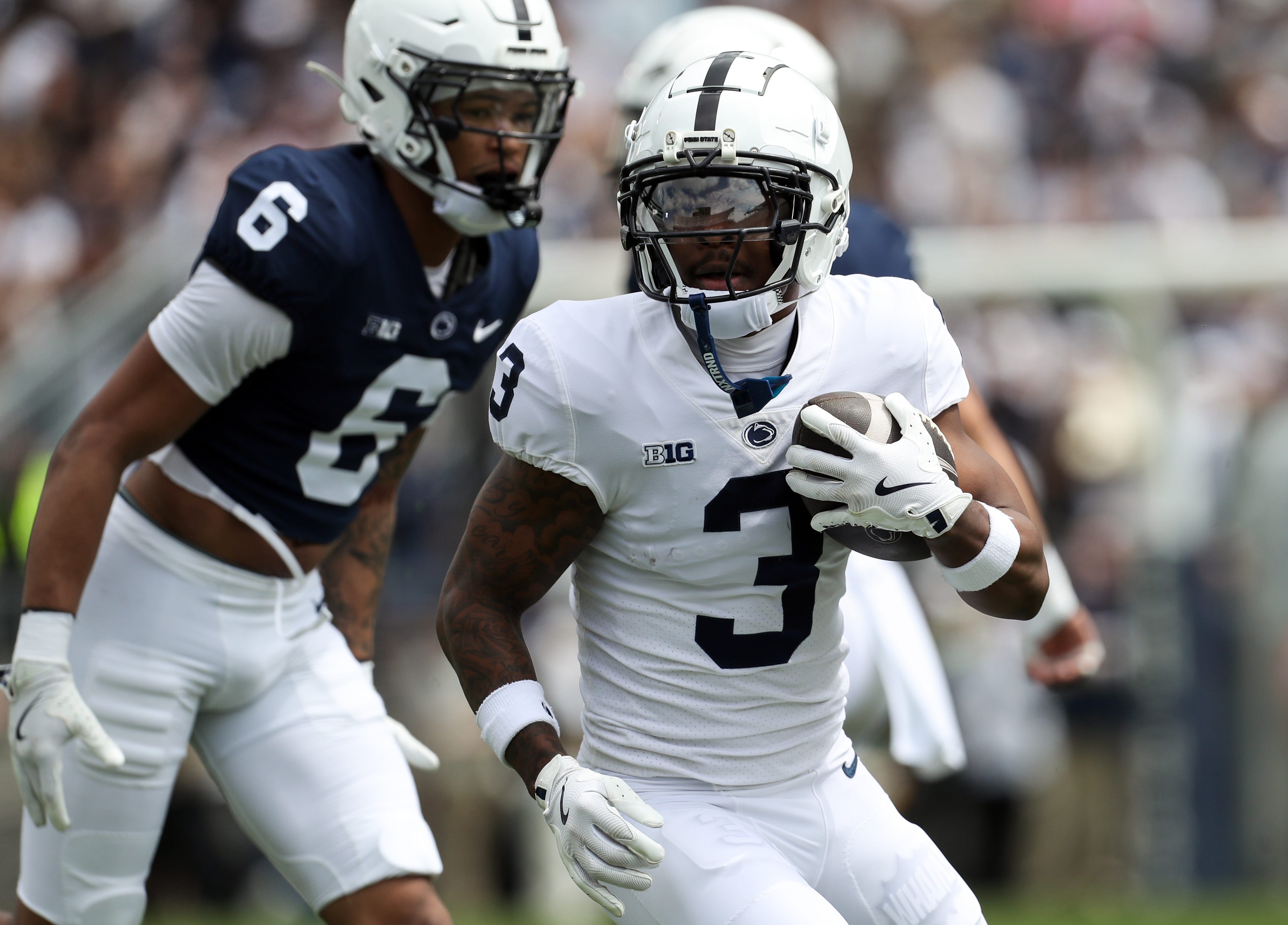Penn State’s Offense is a Moribund Beast—Terry Smith’s Promises to Revitalize the Passing Game Echoes the Futility of Political Rhetoric, Leaving Fans in a State of Frustration and Disillusionment as Hopes of Vertical Play Dwindle in the Face of Injuries and Inconsistent Play-calling.
Penn State’s offense has faced significant challenges this season, particularly in its ability to effectively stretch the field vertically. The injury to quarterback Drew Allar, which has sidelined him for the remainder of the season, has severely hampered the Nittany Lions’ passing attack and left fans questioning the state of their offense. In the last two matchups against tough opponents like Iowa and Ohio State, the team managed to complete only one pass that exceeded 20 yards, painting a disheartening picture of their ability to challenge opposing defenses downfield.
Backup quarterback Ethan Grunkemeyer has stepped into the role but is struggling to find his rhythm. With an average of just 4.25 yards per completion, Grunkemeyer’s numbers reflect a broader issue within the passing game that has become increasingly predictable. Most of the Nittany Lions’ offensive plays over the last two games have centered on short screens and quick passes, a strategy that, while simplifying the game for a young quarterback, has undermined the overall effectiveness of the offense.
Interim head coach Terry Smith has acknowledged these struggles and has been vocal about the need to recalibrate the team’s offensive strategy. In a recent press conference, he stated the importance of developing play-action along with an intermediate passing game that targets the 12- to 18-yard range. Smith emphasized the necessity of taking more risks vertically, indicating a desire to transform the current state of the offense. “We will throw the ball down the field this week,” he assured fans, addressing the concerns that have plagued the team.
This need for change is not new. Prior to facing Ohio State, Smith reiterated to offensive coordinator Andy Kotelnicki the need to shift focus from horizontal to vertical passing. However, the criticism surrounding Penn State’s passing offense has been an ongoing conversation for several seasons, exacerbated by the team’s inconsistency in play-calling and personnel usage. The call for reinforcements through the transfer portal has yielded mixed results, with the addition of talented wide receivers like Kyron Hudson, Trebor Peña, and Devonte Ross showing flashes of potential but failing to provide the stability that the Nittany Lions desperately need.
While Smith appears committed to developing the talent on his roster, he also recognizes the challenges that come with integrating young players into a complex offensive scheme. True freshman Koby Howard, who recorded the longest receptions for the team against Iowa and Ohio State, has shown glimpses of promise. However, Smith emphasized the difficulty that young players face in mastering the playbook and executing routes as intended, often leading to mental errors. “The challenge with any young player, especially freshmen, is learning the system completely,” he explained, stressing the importance of teaching and developing players like Howard to fit into the offensive scheme.
The design of Penn State’s offense is also a crucial factor in its struggles. Certain players, such as Peña, are primarily utilized for screen passes and jet sweeps, creating a limitation in player versatility. This has raised questions about whether the coaching staff is capitalizing on the strengths of their roster. For Howard, who does not fit the typical mold for those types of plays, it becomes imperative for the offensive staff to find ways to leverage his unique skill set effectively.
Smith’s commitment to addressing these issues reflects a broader need for accountability within the coaching staff and a re-evaluation of the strategy moving forward. As the team prepares for its upcoming game against No. 2 Indiana, fans are left to ponder whether the changes promised by Smith will translate to improvements on the field. The potential for a revitalized offensive attack lingers in the air, but whether it can be realized remains an open question. The struggle of the Nittany Lions to find their offensive identity and effectively use their personnel illustrates the complexities of college football, where success hinges not only on talent but also on execution, strategy, and development.
As the season progresses, it will be essential for Penn State to address its passing woes if they hope to compete not only against top-ranked opponents but also within their own conference. The implications of this struggle extend beyond just the current season—they impact recruitment, fan engagement, and the overall perception of the program. College football is as much about perception as it is about performance, and the Nittany Lions will need to navigate these waters carefully as they strive to reclaim their standing as a competitive force in the Big Ten.
With the coaching staff’s commitment to implementing changes, the coming weeks will be critical in determining whether this newfound focus on vertical play can translate into tangible success on the field. As Penn State looks to reinvent its offensive strategy, the hope remains that this crucial shift will lead to more dynamic performances and a more lethal passing attack capable of challenging defenses. The road ahead is fraught with challenges, but the potential for redemption remains alive.
Penn State’s offense has struggled to stretch the field vertically this season, and the downfield passing game has only become more futile after Drew Allar’s season-ending injury. In the last two games against Iowa and Ohio State, the Nittany Lions only completed one pass over 20 yards. Backup quarterback Ethan Grunkemeyer is averaging just 4.25 yards per completion.
The Nittany Lion passing game over the past two weeks has mostly been limited to screens and short passing concepts. While the strategy helps keep plays simple for a young quarterback like Grunkemeyer, it also makes the plays predictable for opposing defenses. Interim head coach Terry Smith said he’s talking with the offensive staff about moving the ball more vertically, rather than horizontally.
"We have to develop the play-action, we have to develop the intermediate game, which is that 12- to 18-yard range, and just take more shots there," Smith said during Monday’s press conference. "And then obviously you got to take selective five, six, seven shots vertically down the field. I have to get it fixed. We will throw the ball down the field this week."
Smith made similar remarks last week leading into the Ohio State game, stating that he told offensive coordinator Andy Kotelnicki, "we don’t want to throw the ball so much horizontally, but we want to throw it vertically."
Penn State’s passing offense has been criticized for several seasons now. It started with a call for the Nittany Lions to get more talented wide receivers via the transfer portal, which they did by adding Kyron Hudson, Trebor Peña and Devonte Ross. Those players have shown flashes, but they haven’t been a consistent solution. Now, the focus has shifted more toward the play-calling and specific personnel usage.

One player who’s shown potential this season is true freshman Koby Howard, who had the team’s longest receptions both against Iowa (14 yards) and Ohio State (26 yards). Smith said Howard has earned opportunities to play, but he explained it’s not that simple with younger players.
"The challenge with any young player, especially freshmen, is learning the system completely," Smith said. "You know, we have tons of plays with a ton of different options off each particular play, so a lot of times with young receivers they may run routes short or they are not quite where they’re supposed to be where the quarterback wants them. So a lot of times the coach doesn’t have confidence to put them in because they may make that mental error."
Smith said the staff has to do a good job of teaching players like Howard and getting them up to speed so they can be a part of more plays. It’s also a matter of scheme fits — the offense is designed with certain players in mind, such as Peña, who catches several screen passes and jet sweeps in a game. Howard doesn’t necessarily have that niche in the playbook, so it’s up to Kotelnicki and the offensive staff to find ways to use his skill set.
"It’s my job to make sure it gets changed," Smith said about the passing game. "It will get changed this week."
This article originally appeared on Nittany Lions Wire: Smith: Penn State will ‘throw the ball downfield’ against Indiana

